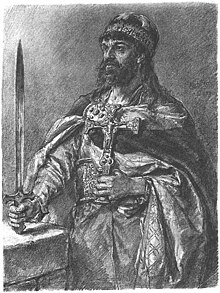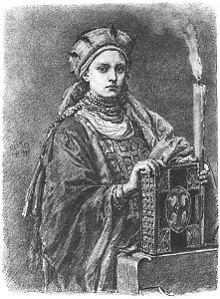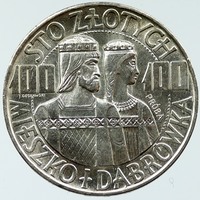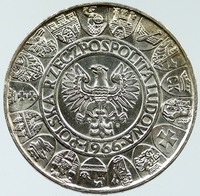Poland - Founding of Poland First Polish King
Mieszko and his wife Doubravka
1966 Silver 'Proba' 100 Zlotych 35mm (20.08 grams) 0.900 Silver (0.5787 oz. ASW)
Reference: KM# Pr146
STO ZLOTYCH MIESZKO + DABROWKA 100 100 PROBA, Busts of King Mieszko and hiw wife Doubravka right.
POLSKA RZECZYPOSPOLITA LUDOWA 1966 in circle around Polish coat-of-arms eagle; all surrounded by shields.
The term PROBA on this coin means is that is a RARE non-circulating trial strike coin. You are bidding on the exact item pictured, provided with a Certificate of Authenticity and Lifetime Guarantee of Authenticity.
 Mieszko I (c. 930 - 25 May 992) was the first ruler of Poland and the founder of the first independent Polish state, the Duchy of Poland. His reign stretched from 960 to his death and he was a member of the Piast dynasty, a son of Siemomysł and a grandson of Lestek. He was the father of Bolesław I the Brave (the first crowned king of Poland) and of Gunhild of Wenden.[2] Most sources identify Mieszko I as the father of Sigrid the Haughty, a Scandinavian queen (though one source identifies her father as Skoglar Toste), the grandfather of Canute the Great (Gundhild's son) and the great-grandfather of Gunhilda of Denmark, Canute the Great's daughter and wife of Henry III, Holy Roman Emperor. Mieszko I (c. 930 - 25 May 992) was the first ruler of Poland and the founder of the first independent Polish state, the Duchy of Poland. His reign stretched from 960 to his death and he was a member of the Piast dynasty, a son of Siemomysł and a grandson of Lestek. He was the father of Bolesław I the Brave (the first crowned king of Poland) and of Gunhild of Wenden.[2] Most sources identify Mieszko I as the father of Sigrid the Haughty, a Scandinavian queen (though one source identifies her father as Skoglar Toste), the grandfather of Canute the Great (Gundhild's son) and the great-grandfather of Gunhilda of Denmark, Canute the Great's daughter and wife of Henry III, Holy Roman Emperor.
He was the first Christian ruler of Poland, but he continued the policies of both his father and grandfather, who initiated the process of creation of the Polish state. Through both alliances and military force, Mieszko extended ongoing Polish conquests and early in his reign subjugated Kuyavia and probably Gdańsk Pomerania and Masovia. For most of his reign, Mieszko I was involved in warfare for the control of Western Pomerania and eventually conquered it up to the vicinity of the lower Oder river. During the last years of his life, he fought the Bohemian state and won Silesia and Lesser Poland. He is sometimes called the "Clovis of Poland" for his role in the founding of Christian Poland. Mieszko I's alliance with the Czech prince, Boleslaus I the Cruel, strengthened by his marriage in 965 to the Czech Přemyslid princess Dobrawa, and his baptism in 966 put him and his country in the cultural sphere of Western Christianity. Apart from the great conquests accomplished during his reign, which proved to be fundamental for the future of Poland, Mieszko I was renowned for his internal reforms, which were aimed at expanding and improving the so-called war monarchy system. According to existing sources, Mieszko I was a wise politician, a talented military leader and a charismatic ruler. He successfully used diplomacy by concluding alliances, first with Bohemia, then Sweden and the Holy Roman Empire. In foreign policy, he placed the interests of his country foremost, even entering into agreements with his former enemies. On his death, he left to his sons a country with greatly expanded territories and a well-established position in Europe. Mieszko I also enigmatically appeared as "Dagome" in a papal document dating to about 1085, called Dagome iudex, which mentions a gift or dedication of Mieszko's land to the Pope (the act took place almost a hundred years earlier). It is roughly to his borders that Poland was returned in 1945.
 Doubravka of Bohemia, Dobrawa (Czech: Doubravka Přemyslovna, Polish: Dobrawa, Dąbrówka; ca. 940/45 - 977) was a Bohemian princess of the Přemyslid dynasty and by marriage Duchess of the Polans. Doubravka of Bohemia, Dobrawa (Czech: Doubravka Přemyslovna, Polish: Dobrawa, Dąbrówka; ca. 940/45 - 977) was a Bohemian princess of the Přemyslid dynasty and by marriage Duchess of the Polans.
She was the daughter of Boleslaus I the Cruel, Duke of Bohemia, whose wife may have been the mysterious Biagota. According to earlier sources, Doubravka urged her husband Mieszko I of Poland to accept baptism in 966, the year after their marriage. Modern historians believe, however, that the change of religion by Mieszko was one of the points discussed in the Polish-Bohemian agreement concluded soon before his marriage with Doubravka. Her role in his conversion is not considered now to be as important as it is often represented in medieval chronicles. In the second half of 964 an alliance between Boleslav I the Cruel, Duke of Bohemia, and Mieszko I of Poland was concluded. In order to consolidate the agreement, in 965 Boleslav I's daughter Doubravka was married to Mieszko I. The marriage cemented the Polish-Bohemian alliance, which continued even after Doubravka's death. Two independent sources attribute to Doubravka an important role in the conversion to Christianity of Mieszko I and Poland. The first is the chronicles of Thietmar, who was born two years before the death of Doubravka. He wrote that the Bohemian princess tried to persuade her husband to accept Christianity (even at the cost of breaking their marriage and with it the Polish-Bohemian alliance). In the end, she finally obtained the conversion of Mieszko I and with him, of all Poland. In turn, the 12th-century chronicler Gallus Anonymus says that Doubravka came to Poland surrounded by secular and religious dignitaries. She agreed to marry Mieszko I providing that he was baptized. The Polish ruler accepted, and only then was able to marry the Bohemian princess. Modern historians agree that the baptism of Mieszko I was dictated by political benefits and should not be attributed to any action of Doubravka. She is held to have had virtually no role in the conversion of her husband. Historians note that the narrative of the conversion of Mieszko I thanks to Doubravka formed part of the tradition of the Church which stressed the conversion of Pagan rulers through the influence of women. Doubravka did have a significant role in the Christianization of the Poles. In her wedding procession, she arrived in Poland with Christian clergymen, among them possibly Jordan, ordained the first bishop of Poland in 968. Tradition attributes to Doubravka the establishment of the Holy Trinity and St. Wit Churches in Gniezno and the Church of the Virgin Mary in Ostrów Tumski, Poznań.
 Poland, officially the Republic of Poland, is a country in Central Europe, bordered by Germany to the west; the Czech Republic and Slovakia to the south; Ukraine and Belarus to the east; and the Baltic Sea, Kaliningrad Oblast (a Russian exclave) and Lithuania to the north. The total area of Poland is 312,679 square kilometres (120,726 sq mi), making it the 69th largest country in the world and the 9th largest in Europe. With a population of over 38.5 million people, Poland is the 34th most populous country in the world, the 8th most populous country in Europe and the sixth most populous member of the European Union, as well as the most populous post-communist member of the European Union. Poland is a unitary state divided into 16 administrative subdivisions. Poland, officially the Republic of Poland, is a country in Central Europe, bordered by Germany to the west; the Czech Republic and Slovakia to the south; Ukraine and Belarus to the east; and the Baltic Sea, Kaliningrad Oblast (a Russian exclave) and Lithuania to the north. The total area of Poland is 312,679 square kilometres (120,726 sq mi), making it the 69th largest country in the world and the 9th largest in Europe. With a population of over 38.5 million people, Poland is the 34th most populous country in the world, the 8th most populous country in Europe and the sixth most populous member of the European Union, as well as the most populous post-communist member of the European Union. Poland is a unitary state divided into 16 administrative subdivisions.
 The establishment of a Polish state can be traced back to 966, when Mieszko I, ruler of a territory roughly coextensive with that of present-day Poland, converted to Christianity. The Kingdom of Poland was founded in 1025, and in 1569 it cemented a longstanding political association with the Grand Duchy of Lithuania by signing the Union of Lublin. This union formed the Polish-Lithuanian Commonwealth, one of the largest and most populous countries of 16th and 17th-century Europe. The Commonwealth ceased to exist in the years 1772-1795, when its territory was partitioned among Prussia, the Russian Empire, and Austria. Poland regained its independence (as the Second Polish Republic) at the end of World War I, in 1918. The establishment of a Polish state can be traced back to 966, when Mieszko I, ruler of a territory roughly coextensive with that of present-day Poland, converted to Christianity. The Kingdom of Poland was founded in 1025, and in 1569 it cemented a longstanding political association with the Grand Duchy of Lithuania by signing the Union of Lublin. This union formed the Polish-Lithuanian Commonwealth, one of the largest and most populous countries of 16th and 17th-century Europe. The Commonwealth ceased to exist in the years 1772-1795, when its territory was partitioned among Prussia, the Russian Empire, and Austria. Poland regained its independence (as the Second Polish Republic) at the end of World War I, in 1918.
 In September 1939, World War II started with the invasions of Poland by Nazi Germany and the Soviet Union (as part of the Molotov-Ribbentrop Pact). More than six million Polish citizens died in the war. In 1944, a Soviet-backed Polish Committee of National Liberation was formed which, after a falsified referendum in 1947 took control of the country and Poland became a satellite state of the Soviet Union, as People's Republic of Poland. During the Revolutions of 1989 Poland's Communist government was overthrown and Poland adopted a new constitution establishing itself as a democracy. In September 1939, World War II started with the invasions of Poland by Nazi Germany and the Soviet Union (as part of the Molotov-Ribbentrop Pact). More than six million Polish citizens died in the war. In 1944, a Soviet-backed Polish Committee of National Liberation was formed which, after a falsified referendum in 1947 took control of the country and Poland became a satellite state of the Soviet Union, as People's Republic of Poland. During the Revolutions of 1989 Poland's Communist government was overthrown and Poland adopted a new constitution establishing itself as a democracy.
Despite the large number of casualties and destruction the country experienced during World War II, Poland managed to preserve much of its cultural wealth. There are 14 heritage sites inscribed on the UNESCO World Heritage and 54 Historical Monuments and many objects of cultural heritage in Poland. Since the beginning of the transition to a primarily market-based economy that took place in the early 1990s, Poland has achieved a "very high" ranking on the Human Development Index, as well as gradually improving economic freedom. Poland is a democratic country with an advanced high-income economy, a high quality of life and a very high standard of living. Moreover, the country is visited by nearly 16 million tourists every year (2013), which makes it one of the most visited countries in the world. Poland is the sixth largest economy in the European Union and among the fastest rising economic states in the world. The country is the sole member nation of the European Union to have escaped a decline in GDP and in recent years was able to "create probably the most varied GDP growth in its history" according to OANDA, a Canadian-based foreign exchange company. Furthermore, according to the Global Peace Index for 2014, Poland is one of the safest countries in the world to live in.
| 

 Mieszko I (c. 930 - 25 May 992) was the first ruler of Poland and the founder of the first independent Polish state, the Duchy of Poland. His reign stretched from 960 to his death and he was a member of the Piast dynasty, a son of Siemomysł and a grandson of Lestek. He was the father of Bolesław I the Brave (the first crowned king of Poland) and of Gunhild of Wenden.[2] Most sources identify Mieszko I as the father of Sigrid the Haughty, a Scandinavian queen (though one source identifies her father as Skoglar Toste), the grandfather of Canute the Great (Gundhild's son) and the great-grandfather of Gunhilda of Denmark, Canute the Great's daughter and wife of Henry III, Holy Roman Emperor.
Mieszko I (c. 930 - 25 May 992) was the first ruler of Poland and the founder of the first independent Polish state, the Duchy of Poland. His reign stretched from 960 to his death and he was a member of the Piast dynasty, a son of Siemomysł and a grandson of Lestek. He was the father of Bolesław I the Brave (the first crowned king of Poland) and of Gunhild of Wenden.[2] Most sources identify Mieszko I as the father of Sigrid the Haughty, a Scandinavian queen (though one source identifies her father as Skoglar Toste), the grandfather of Canute the Great (Gundhild's son) and the great-grandfather of Gunhilda of Denmark, Canute the Great's daughter and wife of Henry III, Holy Roman Emperor.  Doubravka of Bohemia, Dobrawa (Czech: Doubravka Přemyslovna, Polish: Dobrawa, Dąbrówka; ca. 940/45 - 977) was a Bohemian princess of the Přemyslid dynasty and by marriage Duchess of the Polans.
Doubravka of Bohemia, Dobrawa (Czech: Doubravka Přemyslovna, Polish: Dobrawa, Dąbrówka; ca. 940/45 - 977) was a Bohemian princess of the Přemyslid dynasty and by marriage Duchess of the Polans.  Poland, officially the Republic of Poland, is a country in Central Europe, bordered by Germany to the west; the Czech Republic and Slovakia to the south; Ukraine and Belarus to the east; and the Baltic Sea, Kaliningrad Oblast (a Russian exclave) and Lithuania to the north. The total area of Poland is 312,679 square kilometres (120,726 sq mi), making it the 69th largest country in the world and the 9th largest in Europe. With a population of over 38.5 million people, Poland is the 34th most populous country in the world, the 8th most populous country in Europe and the sixth most populous member of the European Union, as well as the most populous post-communist member of the European Union. Poland is a unitary state divided into 16 administrative subdivisions.
Poland, officially the Republic of Poland, is a country in Central Europe, bordered by Germany to the west; the Czech Republic and Slovakia to the south; Ukraine and Belarus to the east; and the Baltic Sea, Kaliningrad Oblast (a Russian exclave) and Lithuania to the north. The total area of Poland is 312,679 square kilometres (120,726 sq mi), making it the 69th largest country in the world and the 9th largest in Europe. With a population of over 38.5 million people, Poland is the 34th most populous country in the world, the 8th most populous country in Europe and the sixth most populous member of the European Union, as well as the most populous post-communist member of the European Union. Poland is a unitary state divided into 16 administrative subdivisions. The establishment of a Polish state can be traced back to 966, when Mieszko I, ruler of a territory roughly coextensive with that of present-day Poland, converted to Christianity. The Kingdom of Poland was founded in 1025, and in 1569 it cemented a longstanding political association with the Grand Duchy of Lithuania by signing the Union of Lublin. This union formed the Polish-Lithuanian Commonwealth, one of the largest and most populous countries of 16th and 17th-century Europe. The Commonwealth ceased to exist in the years 1772-1795, when its territory was partitioned among Prussia, the Russian Empire, and Austria. Poland regained its independence (as the Second Polish Republic) at the end of World War I, in 1918.
The establishment of a Polish state can be traced back to 966, when Mieszko I, ruler of a territory roughly coextensive with that of present-day Poland, converted to Christianity. The Kingdom of Poland was founded in 1025, and in 1569 it cemented a longstanding political association with the Grand Duchy of Lithuania by signing the Union of Lublin. This union formed the Polish-Lithuanian Commonwealth, one of the largest and most populous countries of 16th and 17th-century Europe. The Commonwealth ceased to exist in the years 1772-1795, when its territory was partitioned among Prussia, the Russian Empire, and Austria. Poland regained its independence (as the Second Polish Republic) at the end of World War I, in 1918. In September 1939, World War II started with the invasions of Poland by Nazi Germany and the Soviet Union (as part of the Molotov-Ribbentrop Pact). More than six million Polish citizens died in the war. In 1944, a Soviet-backed Polish Committee of National Liberation was formed which, after a falsified referendum in 1947 took control of the country and Poland became a satellite state of the Soviet Union, as People's Republic of Poland. During the Revolutions of 1989 Poland's Communist government was overthrown and Poland adopted a new constitution establishing itself as a democracy.
In September 1939, World War II started with the invasions of Poland by Nazi Germany and the Soviet Union (as part of the Molotov-Ribbentrop Pact). More than six million Polish citizens died in the war. In 1944, a Soviet-backed Polish Committee of National Liberation was formed which, after a falsified referendum in 1947 took control of the country and Poland became a satellite state of the Soviet Union, as People's Republic of Poland. During the Revolutions of 1989 Poland's Communist government was overthrown and Poland adopted a new constitution establishing itself as a democracy.
